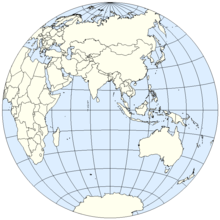Western and Eastern Hemisphere
The prime meridian and longitude 180, which is about the dateline corresponds to share the earth in two hemispheres ( hemisphere ), the Western and Eastern Hemisphere . In contrast to the northern and southern hemispheres , this division is not given by the geometry of the earth, but rather determined by the prime meridian agreed internationally in 1884.
Occasionally, the hemispheres are divided into two 90 degree wide quadrants for geoscientific purposes , but these have no proper names, but are described with the help of their border meridians (e.g. "Quadrant 90 ° W – 180 °").
According to this definition, Europe west of London , West Africa (including the Maghreb ), most of the Atlantic , America and large parts of the Pacific belong to the Western Hemisphere. Overall, only around 15 percent of the world's population live in the western hemisphere, in the eastern hemisphere, which includes Asia , corresponding to 85%.
Today, the Western Hemisphere usually means the New World , i.e. the double continent America and the surrounding islands, including the Caribbean , especially from the point of view of the Monroe Doctrine of the United States.
During the Cold War , the Western Hemisphere was the name given to that part of the world whose political principles were based on the United States or which was a member of NATO .
See also
Individual evidence
- ↑ James K. Angell: Contraction of the 300 mbar north circumpolar vortex during 1963-1997 and its movement into the eastern hemisphere. In: Journal of Geophysical Research , Vol. 103, No. D20, October 27, 1998. pp. 25, 887-925, 893.
- ^ Robert E. Davis, SR Benkovic: Climatological variations in the Northern Hemisphere circumpolar vortex in January . In: Theoretical and Applied Climatology , Volume 46 (2), 1/1992. Pp. 63-73

